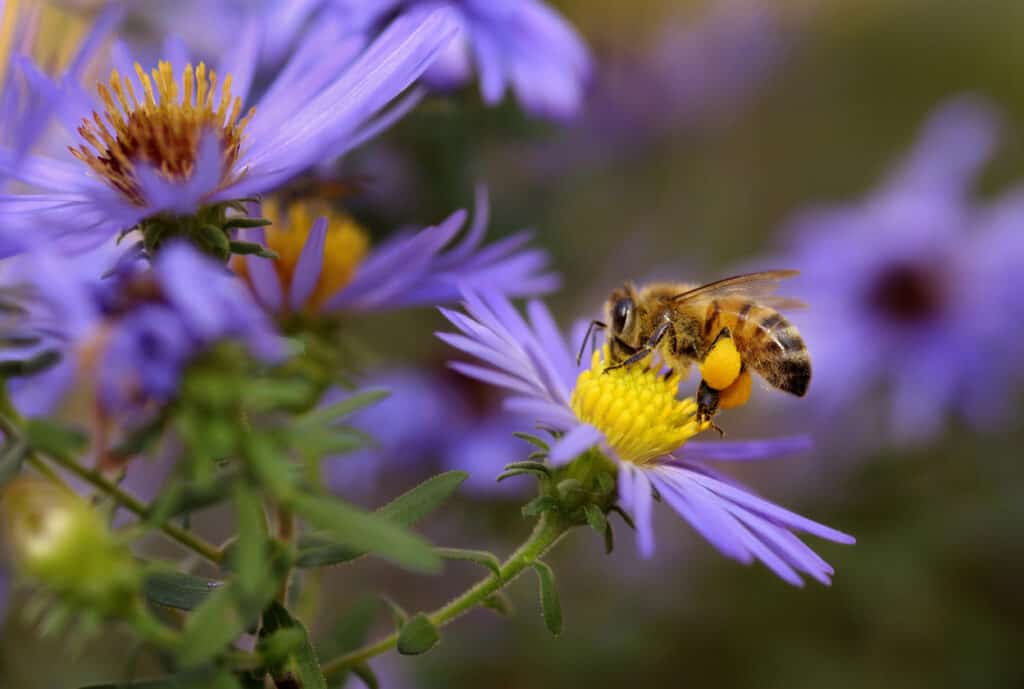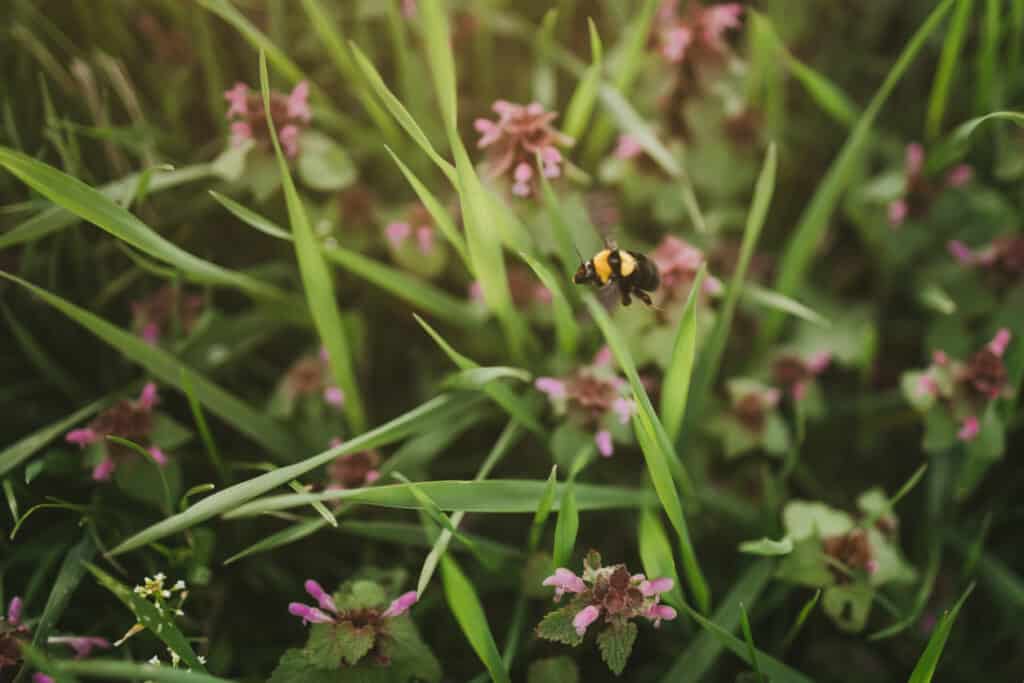Did you know that there are approximately 17 000 different species of bees? The most well-known bee is the western honey bee, whom we can thank for providing us with delicious honey. A common question plaguing many peoples’ minds is whether or not their buzzing little bee friends are insects or some other critter like a bug. So which category do bees fit into; are they, in fact, insects or not?
All bee species are insects falling under the Class Insecta; scientists classify animals into different classes through shared characteristics. You can classify insects as animals with three sets of legs, three distinct segments or body parts, and four wings. Bees share all of these physical traits.

It might be beneficial to delve deeper into what an insect is and how bees fit into this category. It’s easy to say bees are insects, but what does this mean? Why are bees classified as insects? Only once you have all the facts can you fully grasp the concept of bees being part of the insect class. As an interesting side note, it might be a good idea to look into whether or not bees are bugs and if bees and wasps are the same species.
Can You Classify Bees As Insects?

There are multiple different types of bees in the world. Some are teenie tiny, and others are as large as 1.5 inches. Some bees like to live in colonies that can grow to include thousands of individuals, and others want to live a more solitary lifestyle. No matter their size or which bee family they fit into, they are all categorized as insects.
The Classification System

There are seven levels to the classification system, which places all living organisms into categories based on shared common characteristics. This system encompasses every recorded and identified living organism on the planet. Scientists set up this classification system so that they could study the animal and plant life on the earth.
Before adequately studying an organism, you need to give it a name so that future researchers don’t get confused about which species you are referring to when discussing them. Before we can discuss why we have categorized bees as insects, let’s look at how they fit into the first three levels of the classification system.
Kingdom: Animalia
All living things on the planet fall under different categories, from viruses to fungi and from trees to animals. Bees fall under the Animal Kingdom, meaning that they are animals. All invertebrates (living organisms without a spine or bones) and vertebrates (living organisms with a spine and bones) are animals.
A bee would need other distinguishing features to fit in with the classification of being an animal. These include:
- First, a bee would need to be multicellular, meaning it would need to be made up of more than one cell.
- Second, a bee would need to be able to bring food into its body and break it down for nutrients and energy. Instead of creating its food as a tree does.
- Third, a bee would need to be able to move around. When we say moving around, we mean that at some point in a bee’s life cycle, they should be able to move from one place to another of their own accord. They could do this by walking, flying, crawling, swimming, slithering, rolling, wriggling, or hopping.
- Fourth, animals need to be soft and pliable, which means they can’t have rigid cell walls, meaning they can’t be woody like a tree.
As bees can fly and eat, have many cells, and do not have rigid cell walls, we can happily classify them as animals. So off to the next level of the classification system.
Phylum: Arthropoda
The next level to consider is the Phylum. Here you can further classify a bee based on its general characteristics. To form a part of the Arthropoda Phylum, animals must have a few distinguishing features. These features include an exoskeleton, at least three pairs of legs, and a segmented body. As bees have all of these features, they join the Phylum Arthropoda.
Class: Insecta
Next, we get to the Class level. Here animals part of a Phylum are further divided into classes based on shared similarities. Bees have managed to get themselves grouped into the Class Insecta, or in layman’s terms, insects, because they share some similar physical characteristics with other animals in this Class. Now that we know how you classify bees as insects, it might be a good idea to look at what features an animal needs to have to get them placed in the Class Insecta.
What Are The Distinguishing Features Of An Insect?
Insects are amazing creatures. They are the only invertebrates on the planet with wings. They play a vital role in every environment, including pollinating plants, serving as a good food source, and aiding in the decomposition of animals and plants. There are 29 different sub-orders in the Class Insecta. The most crucial sub-order for our purposes is that of the Hymenoptera, which includes bees, sawflies, wasps, and ants.
There are many exceptions when distinguishing the external features of the animals in the Class Insecta. For this reason, it is pretty challenging to produce a typical body plan for all insects. Yet, luckily for us, there are some general features that most insects possess.
General insect features include:
- Insect bodies have three main parts: the abdomen, head, and thorax.
- Insects do not have an internal skeleton. Instead, they possess an exoskeleton that protects their internal organs.
- Insects sport a single pair of antennae on their heads.
- Typically insect mouths have an upper jaw called a mandible and a lower jaw called maxillae which work together to bite things. Although, when it comes to insects, the variation in this aspect is extensive. Blood-sucking creatures and bugs have stabbing and sucking mouthparts, butterflies and moths have mouthparts with tubular suckers on them, and some adult insects don’t have any functional mouthparts.
- Insects have only three pairs of legs. Any animal with more than three pairs is not an insect.
- Regarding the wings, most insects have four wings, either one or two pairs. Although some insects are entirely wingless, examples of these include fleas, lice, and silvertails.
Why Are Bees Classified As Insects?
It all comes down to shared physical traits; this is how you classify an animal into a different Class. Bees possess many of the shared typical characteristics that make them insects. Let’s look at these a few of these features in greater detail.
Skeletons
Bee’s do not have an internal skeleton, meaning they do not have any bones. Instead, their bodies are covered in an exoskeleton made up of chitin secreted by their epidermal cells. The chitin is hard and brittle and forms a cuticle covering the bee’s body’s outer surface that protects all soft internal organs. The exoskeleton of a bee is hairy to enable it to detect vibrations in the air, collect pollen, and regulate its body temperature.
Bees need this exoskeleton to provide their bodies with a shape, allow them mobility and flexibility, and provide waterproofing. It also protects them against diseases as chitin has anti-fungal and antimicrobial properties.
Body Parts
Three main body parts comprise a bee’s physical anatomy: the abdomen, head, and thorax.
The head is at the top of their bodies, followed by the abdomen, which features nine segments; the last three have evolved and adapted to form their stingers. The thorax sits behind the abdomen and features three parts, each containing a robust pair of legs; the last two segments each feature a pair of wings.
The Head
Bees have a beautiful set of antennae on their heads extending forward in a unique el-bow-like angle, allowing their terminal segments to bend at a right angle. They have three single eyes positioned on the tops of their heads with two compound eyes. These eyes allow bees to detect movement, see color, and judge distance. They can also see ultraviolet and detect the polarization of light.
On the lower portion of their heads is where you will find a bee’s mouthparts made up of a biting jaw or mandible and an elongated sucking-mouth part called a proboscis. Bee’s can identify salty and sour tastes and distinguish slight differences between bitter and sweet.
The Thorax
The three segments that comprise the thorax are box-like, and each has a pair of legs extending from the lower portion. The legs are robust, and in corbiculate bees (bees that have pollen baskets on their legs), the front legs have special combs for cleaning the antennae. Many bee species have pollen baskets on their hind legs, which feature flattened sections and incurving hairs that will act to secure the collected pollen.
The bee’s wings are attached to the top portion of the back two segments. Regarding the size of the wings, the hind wings are typically smaller than the fore wings, and along their margins, the two sets of wings are attached by a row of hooks. The two wings synchronize during flight.
The Abdomen
The nine segments in a bee’s abdomen appear as a series of similar rings. Each of these rings or segments features a pair of openings referred to as spiracles. These spiracles provide an outlet for the bee’s internal respiratory system. The last three segments on most bees are specially adapted and feature a stinger.
Which Of The Common Insect Traits Do Bees Have?
When looking at the bee’s physical traits, we can see why they are part of the Class Insecta.
- All insects have three main components to their bodies, and bees have these too.
- Insects have wings and six legs, and bees have wings and six legs.
- Insects have exoskeletons, and bees have exoskeletons.
- Insects have antennae, and bees have antennae.
- Typically insects have a mandible and maxillae, which work together to form a biting jaw, and bees have a biting mandible and an elongated sucking mouth part.
These physical characteristics are necessary for an animal to get classified as an insect. As we can see from all the information above, bees fit this description nicely.
Are Bees Bugs?
It might be surprising to hear, but bees are not bugs. Yes, both bugs and bees belong to the same Class Insecta, but they belong to different Orders. Bugs form part of the Order Hemiptera, whereas bees form part of the Order Hymenoptera.
Generally speaking, insects belonging to the Order Hymenoptera are small to medium-sized. They have two sets of wings, a narrow waist that sets the thorax and abdomen off from one another, and their mouth parts are either of the biting-sucking type or the biting type.
Insects belonging to the Order Hemiptera, on the other hand, have mouthparts adapted to piercing animal or plant tissue. They have an X-shaped design on their backs formed by their wings when resting, and the underside of their heads is hardened.
These differences, although they might seem small, are enough to ensure that you cant classify bees as bugs.
Are Bees And Wasps The Same?
Bees and wasps are closely related and part of the same Order, Hymenoptera. They are not part of the same Family classification and are therefore not the same. Inside the Order, you can further separate wasps and bees into different Families based on some of their specific traits.
Bees belong to the Family Apidae, while their cousins, the wasp, belong to the Family Vespidae. Bees predominantly fly around to gather nectar and pollen, whereas wasps fly around to hunt other insects. Typically a bee sting will result in the untimely demise of the bee in question, whereas wasps can sting you multiple times without having to worry.
Conclusion
Bees form part of the Class Insecta, which means they are indeed insects. Insects have an exoskeleton, are invertebrates, and have three main body parts, three pairs of legs, antennae, compound eyes, wings, and biting or sucking mouths. When looking at the different physical features of a bee, you will notice that they share all of these traits, which is why you can happily classify them as insects.
References
https://www.buzzaboutbees.net/what-is-a-bee-is-a-bee-an-insect.html
https://www.honeybeesuite.com/are-bees-insects-or-animals/
https://www.britannica.com/animal/bee
https://en.wikipedia.org/wiki/Bee
https://www.buzzaboutbees.net/do-bees-have-an-exoskeleton.html
https://bee-health.extension.org/adult-bee-anatomy-basic-bee-biology-for-beekeepers/
https://kids.britannica.com/students/article/bee/272933
https://australian.museum/learn/animals/insects/what-are-insects/
https://www.britannica.com/animal/insect

